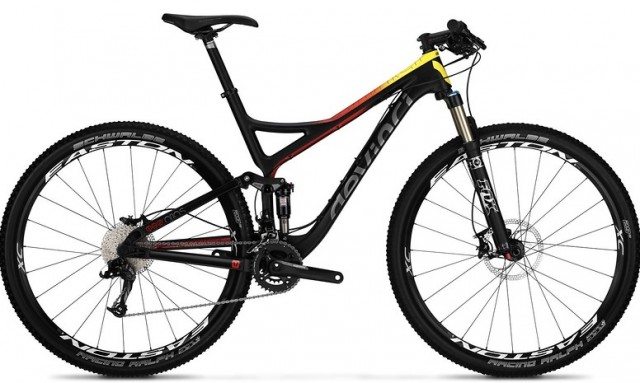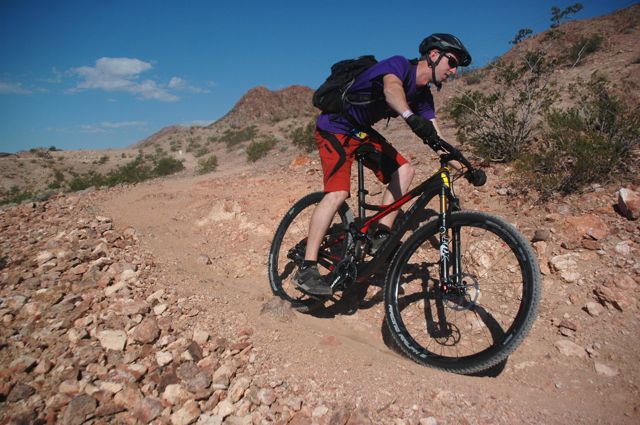
2014 Devinci Atlas Carbon RC
Frame: Carbon DMC-G
Size Tested: Medium (24.1″ top tube)
Wheels: 29″
Travel: 110mm
Rider Info: 5’9”, 150 lbs.
The Build:
- Fox Float CTD Adjust Factory Series
- Fox Float 32 CTD FIT 29 120mm
- Shimano XT M786 Shadow+
- Shimano SLX M675
Days Tested: 1
Test Location: Bootleg Canyon, Boulder City, Nevada
The Caveat
We just got back from a day of testing bikes on the rocky trails around Boulder City, Nevada, during the annual Interbike Outdoor Demo. We’ll roll out First Looks of other bikes during the next week (including the Pivot Mach 6 and the Devinci Troy), so stay tuned. But before we get to our initial impressions of the Atlas, an important caveat:
Riding bikes at a demo is always kind of tricky. For starters, we didn’t get much time on each bike—at most around an hour, and with many bikes it was just a 25-minute loop. 25 minutes can tell you a lot about how a bike handles, but it certainly doesn’t allow for the customary in-depth, BLISTER analysis.
In addition, these bikes are set up by mechanics at each company’s booth, and while these guys do a great job, there isn’t really time to get each bike dialed for how I’d normally set it up. (If nothing else, I probably would have put wider bars on most of the bikes I rode.)
And then there are the trails. Interbike’s Outdoor Demo takes place at Bootleg Canyon in Boulder City. It’s a little bastion of awesomeness that overlooks the pit of despair that is Las Vegas, and the trails are fantastic: super rocky, with lots of sand, some rocks, some jumps here and there, and did I mention the rocks? Most of my time on these bikes was spent on the more cross-country oriented trails, even though the DH trail system is (in my opinion) the crown jewel of the Bootleg trail network.
The XC trails have a good mix of flowy corners, short punchy climbs, rock gardens, and a bit of chunder. All in all, they’re decent for testing out the different aspects of a given bike, but to really develop a feel for how a bike works, there’s no substitute for riding it for a long time on a lot of different types of trails.
So with all that in mind, let’s now talk about the Devinci Atlas.

First Impressions
By the numbers, the Atlas looks like a more or less standard-fare 29’r, and to some extent, it is. It’s not a mindblowing bike per se, but it’s an extremely capable bike—and in case you’ve forgotten, “extremely capable” is a pretty big compliment to pay a bike.
The Atlas was the first bike I rode, so it got the honor of being the bike that I took down a rocky trail that I’d never ridden before. As will happen, I maybe got a bit ahead of myself and was riding semi-fast. As will also happen, this led to some interesting line choices.
The Atlas took all of this in stride. While it’s not in the same class as some of the longer travel, slacker trail bikes out there, it still managed to blast through chunky rock gardens with a reasonable amount of composure.
I’m always hesitant to call any 29er “playful,” but the Atlas at least deserves to be in the same sentence as that word—something that can’t be said for a lot of the 29er offerings out there. The Atlas sports impressively short 16.9″ chainstays, which I think is the primary cause of the bike’s flickability. It was pretty happy being whipped around corners, and it felt downright nimble through technical sections. I wouldn’t go so far as to say that I forgot I was on a wagon wheeler, but I didn’t feel like I was fighting the big wheels through every corner, which is nice.
The short chainstays also make it easy to get the front end of the bike up—manualing over whoops or rocks was as easy as you would expect on a bike with sub-17″ stays. If you didn’t have any expectations in this regard, then you can now file this away: bikes with sub 17″ stays should be easy to manual. If they’re not, that probably means that the suspension sucks. (And yes, we’re going to blame it on the bike, not the rider.) Anyway, the Atlas didn’t have this problem, and the suspension worked just fine.
Suspension
So about that suspension: the Atlas, like all Devinci bikes, uses the split pivot design, meaning that there’s a pivot concentric to the rear axle. The chainstay pivots around a point a bit above the bottom bracket, and the rear shock is actuated via a short rocker arm. The rear end of the Atlas also has a flip chip that allows you to adjust the geometry slightly.
One of the main selling points of the split pivot design is that it does well under braking. I’ve ridden other split pivot bikes and have generally found this to be true, but there weren’t any really nasty braking sections on the loop where I rode the Atlas. So, while I don’t have any concerns on that issue, I also didn’t notice the Atlas to behave one way or another—exceptionally well or surprisingly poorly—under braking.
In terms of bump compliance, I found the suspension on the Atlas to be pretty good on the way down—it neutralized bumps without blowing through its travel, and I didn’t feel like it dove deep into its travel on g-outs or bermed corners. On the climbs, there was some noticeable bob unless the Fox Float CTD was put into climb mode. The Atlas wasn’t horrible for pedal bob, but I didn’t find it to be great, either.
Bottom Line (For Now)
There are now seven trillion bikes in the 4.5″ travel segment, and many of them are 29ers. The Atlas is a solid contender in this class, and would be a great choice for someone looking to capitalize on the benefits of the larger wheel size, but who still wants the bike to retain some maneuverability. Some bikes in this category skew pretty heavily toward being long-legged XC-racers, and that’s definitely not where I’d place the Atlas. It’s more cooperative through tight terrain, and it’s more confidence inspiring in the tech.
If you’re in the market for a 5″ travel 29er and you’re more concerned with having an enjoyable bike to get rad on than you are about your Strava times, then the Atlas is definitely worth a look.

Hello Mr. Bodman
Kind Regards from Costa Rica
I’m on the midle of a deal, between buying one carbon or aluminum frame, my big concernd is that I’m 6.3(1.84m) and 105k(231pounds).
I’m a “standard” rider no jumps, no downhill, nothing extreme, but like a good bike, that may give me comfort, control etc,
In my country most of the trails are full of hills, and heavy ones, on the last month I put my eye con the DEVINCI Atlas carbon 29er, reading your article I feel move to write to you asking for your help on this selection.
Thanks
Enrique